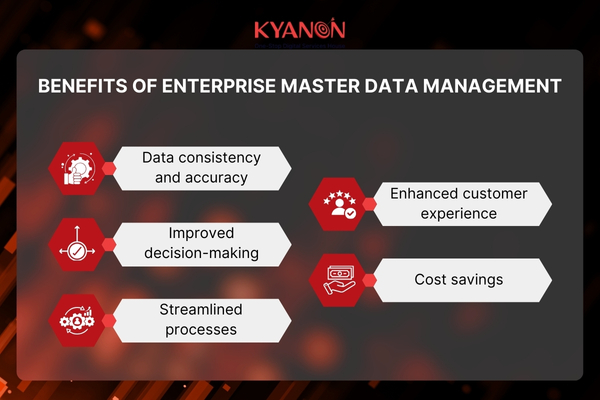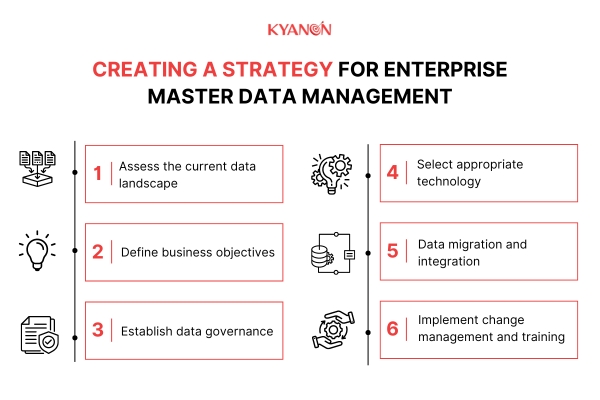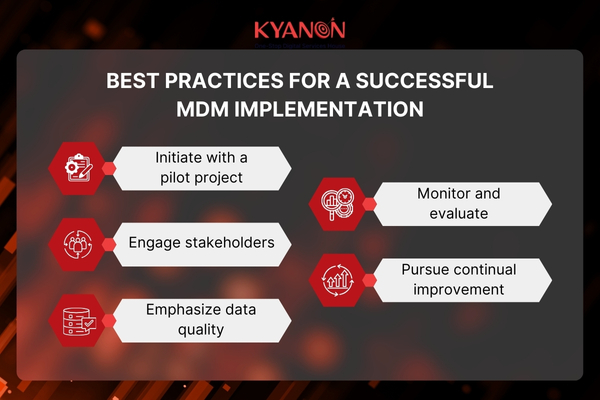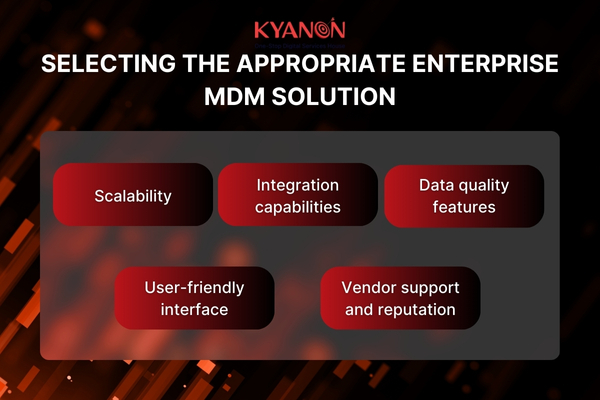Master Your Data: Essential Tips for Enterprise Master Data Management
The global master data management (MDM) market was valued at approximately USD 19.9 billion in 2023, and it’s on track for rapid expansion with an expected compound annual growth rate (CAGR) of 17.4% through 2030. This growth is primarily driven by the rise of cloud computing and hybrid IT environments, which demand MDM solutions that can integrate seamlessly across multiple systems and platforms.
As companies look for solutions to improve data management, MDM tools are increasingly popular for their flexible deployment options, scalability, and interoperability across cloud and on-premises infrastructures. These tools enable organizations to harness data effectively, providing real-time insights, enhancing collaboration, and boosting agility to respond quickly to changing business needs.
In this blog, we’ll dive into essential tips for enterprise master data management to help you make the most of your data strategy, optimize decision-making, streamline operations, and elevate customer experiences!

1. Boost Operational Efficiency with These Tips for Enterprise Master Data Management
Enterprise Master Data Management (MDM) plays a key role in ensuring organizations have a unified, reliable view of their data, which can greatly improve efficiency. By streamlining data management across departments, systems, and locations, MDM helps organizations operate more effectively.
Here’s why MDM is critical for operational efficiency:
1.1 Consistency Across Systems
MDM ensures that data is consistent, no matter where it’s stored or used. Without MDM, data can become fragmented or duplicated across different systems, leading to confusion and errors. With a single, accurate source of truth, businesses can confidently rely on their data for decision-making.
1.2. Improved Decision-Making
When data is accurate and consistent, it becomes easier to make informed decisions. For instance, a sales manager can quickly access up-to-date customer information across various platforms, leading to more effective sales strategies. This clarity also helps managers and executives make faster, more reliable decisions on the fly, enhancing the overall speed of business processes.
1.3. Better Collaboration Across Departments
Without MDM, different departments may be using different versions of the same data, leading to misunderstandings and inefficiencies. MDM ensures that every department—from finance to HR—has access to the same accurate and standardized data, fostering collaboration and aligning all teams toward common goals.
1.4. Faster Data Processing
By automating data management tasks like cleaning, validating, and standardizing, MDM reduces the time spent manually handling data. This leads to faster operations, allowing your organization to focus more on innovation and strategic initiatives rather than data maintenance.
1.5 Cost Savings
With a well-executed MDM strategy, businesses can save money by eliminating redundancies, reducing errors, and minimizing the need for costly data correction. Additionally, MDM helps businesses avoid penalties related to non-compliance and improves operational efficiency, ultimately leading to long-term cost reductions.
1.6. Scalability and Growth
As businesses grow, their data management needs become more complex. MDM systems are designed to scale with the organization, allowing them to handle increasing data volumes and evolving business needs. This makes MDM a future-proof investment, ensuring your organization remains efficient even as it expands.

2. The Challenges of Managing Data in a Big Business
Managing data in large organizations is no small feat. With data flowing in from a variety of sources—such as sales teams, marketing, HR, and customer service—keeping it consistent and organized becomes increasingly difficult. Without a proper system in place, this data can become fragmented and inconsistent, leading to significant challenges in day-to-day operations.
2.1. Data Fragmentation
In big businesses, data is often scattered across different systems, databases, and departments. This fragmentation results in multiple versions of the same data, which can cause confusion and errors. Without proper integration, the data lacks consistency, making it harder for teams to collaborate and make informed decisions.
Tips for Enterprise Master Data Management: A unified MDM strategy ensures that all data is stored in one central system, reducing fragmentation and allowing for consistent, accurate data across the organization.
2.2. Data Duplication
When data is not properly managed, it’s easy to have duplicate entries across multiple systems. This duplication wastes time and resources, as teams may unknowingly work with incorrect or outdated information. It also complicates reporting and analysis, making it difficult to gain clear insights.
Tips for Enterprise Master Data Management: Centralized data management helps eliminate duplicates, ensuring that each piece of data is only stored once and can be accessed seamlessly by all departments.
2.3. Poor Data Quality
Inconsistent and inaccurate data can lead to unreliable insights, which hinder decision-making. When data quality is compromised, the effectiveness of any business analysis or forecasting becomes questionable. This can directly impact the company’s ability to spot trends, predict customer behavior, or optimize operations.
Tips for Enterprise Master Data Management: Prioritize data cleansing and validation within the MDM process to ensure that the information is reliable, up-to-date, and useful for decision-making.
2.4. Lack of Data Centralization
Without a centralized data management approach, various departments may operate with their own sets of data, leading to silos within the organization. This lack of centralization not only makes data difficult to access but also complicates efforts to maintain data integrity.
Tips for Enterprise Master Data Management: An effective MDM strategy brings data from across departments into a single source of truth, allowing stakeholders to access the most accurate and up-to-date information.
2.5. Compliance and Security Risks
As data grows, so do the challenges of ensuring it is secure and compliant with regulations. Organizations face increasing pressure to protect sensitive customer data and ensure compliance with data protection laws like GDPR or CCPA. A lack of centralized management can leave sensitive data vulnerable to breaches or mishandling.
Tips for Enterprise Master Data Management: Implementing a robust MDM system with strong data governance protocols ensures compliance and helps safeguard sensitive information, reducing the risk of security breaches and legal consequences.

3. Benefits of Enterprise Master Data Management
Implementing enterprise MDM offers several advantages for organizations.

3.1. Data consistency and accuracy
MDM ensures that all data remains consistent, standardized, and accurate, irrespective of its origin or the system it resides in. This eradicates data discrepancies and fosters trust in data for decision-making purposes.
3.2. Improved decision-making
Armed with reliable and current data, organizations can swiftly and confidently make informed decisions. MDM provides a singular source of truth that enables stakeholders to access pertinent information when needed.
3.3. Streamlined processes
MDM enables organizations to enhance their processes by eliminating redundant data entry, minimizing manual errors, and automating data integration. This results in heightened operational efficiency and productivity.
3.4. Enhanced customer experience
By possessing a comprehensive and precise understanding of customer data, organizations can deliver personalized and targeted experiences. MDM equips organizations to comprehend their customers better, predict their requirements, and offer exceptional service.
3.5. Cost savings
MDM aids organizations in cutting costs by curbing data duplication, eradicating manual data reconciliation efforts, and enhancing data quality. Additionally, it mitigates the risk of non-compliance penalties and data breaches, both of which can incur substantial expenses for organizations.
4. Creating a Strategy for Enterprise Master Data Management
Crafting an enterprise MDM strategy necessitates meticulous planning and alignment with organizational objectives. Here are essential steps to guide you.

4.1. Assess the current data landscape
Gain insight into your organization’s existing data landscape, encompassing systems, processes, and data sources. Identify data quality issues, duplication, and areas for enhancement.
4.2. Define business objectives
Clearly articulate the business goals that MDM seeks to accomplish. Identify key performance indicators (KPIs) to gauge the effectiveness of your MDM strategy.
4.3. Establish data governance
Develop policies, processes, and roles for data governance within your organization. Consider employing a dedicated data governance solution and ensure clear accountability for managing data quality, security, and compliance.
4.4. Select appropriate technology
Choose an MDM solution that aligns with your organization’s needs, considering factors like scalability, flexibility, and integration capabilities with existing systems.
4.5. Data migration and integration
Devise a comprehensive plan for migrating and integrating data into the MDM system. Ensure thorough cleansing, validation, and mapping of data to the relevant fields.
4.6. Implement change management and training
Deploy a change management strategy to facilitate seamless adoption of the MDM system. Provide comprehensive training and support to stakeholders to foster an understanding of the benefits and proficient usage of the system.
5. Best Practices for a Successful MDM Implementation
For a successful enterprise MDM implementation, adhere to these best practices.

5.1. Initiate a pilot project
Commence with a pilot project to validate the efficacy of your MDM strategy. This enables the identification of potential issues and allows for adjustments before expansion.
5.2. Engage stakeholders
Involve key stakeholders from various departments in the MDM implementation process. This ensures consideration of their needs, fostering ownership and support for the project.
5.3. Emphasize data quality
Maintain a focus on data quality throughout the implementation phase. Invest in activities like data cleansing, validation, and enrichment to ensure the accuracy and reliability of data in the MDM system.
5.4. Monitor and evaluate
Continuously monitor and assess the performance of your MDM system. Regularly review data quality metrics, KPIs, and user feedback to pinpoint areas for enhancement and make necessary adjustments.
5.5. Pursue continual improvement
Enterprise MDM is an evolving endeavor. Regularly evaluate and refine your MDM strategy to accommodate evolving business requirements, technological advancements, and data governance standards.
6. Selecting the Appropriate Enterprise Master Data Management Solution
The selection of an enterprise MDM solution is pivotal for the success of your implementation. Consider the following factors when assessing MDM vendors.
- Scalability: Ensure that the chosen MDM solution can accommodate your organization’s expanding data requirements and future growth plans effectively.
- Integration capabilities: Evaluate the MDM solution’s capacity to seamlessly integrate with your existing systems, databases, and applications. Smooth integration is essential for maintaining data consistency and accessibility.
- Data quality features: Seek MDM solutions that provide robust features for data cleansing, validation, and enrichment. These functionalities are imperative for upholding data accuracy and integrity.
- User-friendly interface: An intuitive interface plays a significant role in user adoption and usability. Look for an MDM solution with user-friendly navigation, customizable dashboards, and comprehensive search functionalities.
- Vendor support and reputation: Opt for a vendor with a proven track record in enterprise MDM and commendable customer support. Review customer testimonials, case studies, and references to gauge the vendor’s reputation.

7. Key Metrics to Measure Enterprise Master Data Management Success
Tracking Enterprise Master Data Management (MDM) success requires a focus on core metrics to assess the program’s alignment with business objectives. Here are essential KPIs for evaluating MDM effectiveness:
7.1. Data Quality Score
A vital metric for enterprise MDM, the data quality score evaluates the accuracy, completeness, and consistency of data across systems. A high data quality score indicates that MDM is effectively supporting accurate, data-driven decisions across the organization.
7.2. Data Redundancy Reduction
Reducing data redundancy is key to efficient data management. By measuring the decline in duplicate data entries, this KPI provides insight into the MDM program’s success in consolidating enterprise data, which helps cut storage costs and improve system performance.
7.3. User Adoption Rate
High user adoption shows that departments find the MDM system accessible and valuable, driving consistent data usage across the enterprise. This metric highlights the system’s usability and its integration into organizational workflows, which is essential for sustained MDM success.
7.4. Compliance Rate
For enterprise-level MDM, compliance with data governance standards such as GDPR or CCPA is crucial. Tracking this metric can reduce legal risks, protect data integrity, and avoid costly penalties, ensuring the enterprise meets regulatory obligations.
Kyanon Digital and Semarchy: Your Data partner for success
As organizations increasingly adopt digital transformation and prioritize data-driven decision-making, the significance of MDM will grow even further. MDM is poised to play a pivotal role in empowering organizations to leverage the potential of their data, providing them with a competitive advantage in today’s dynamic business environment.
Kyanon Digital has officially partnered with Semarchy, a globally recognized leader in unified data management platforms. This partnership brings together the innovative expertise of Kyanon Digital with Semarchy’s renowned solution, Semarchy xDM for the enterprise.
Contact us for data management consulting services for your business today!


